Digital Poster
Prostate MR Techniques & New Methods
ISMRM & ISMRT Annual Meeting & Exhibition • 10-15 May 2025 • Honolulu, Hawai'i

 |
Computer Number: 17
2436. On
the optimal analytic approach to luminal water fraction
estimation in prostate cancer MRI: Simulations and in vivo
validation
J. Zhang, Q. Kong, C. Yang, J. Xiao, F. Han, A. Lim, M.
Aron, S. Cen, Z. Fan
University of Southern California, Los Angeles, United States
Impact: The MC-G-4 and MC-D-2 models significantly
enhance luminal water fraction estimation in prostate cancer
MRI, offering robust, accurate, and noise-resilient tools
that improve lesion detection and characterization, thereby
potentially leading to better patient outcomes in clinical
practice.
|
|
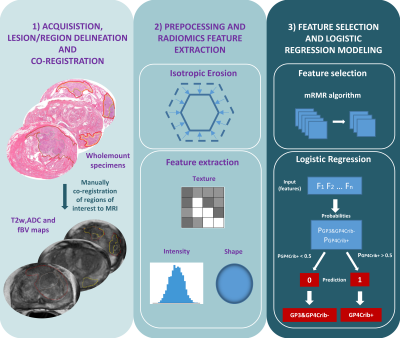 |
Computer Number: 18
2437. Beyond
Gleason Grading: MRI radiomics to differentiate cribriform
growth from non-cribriform growth in prostate cancer men
M. Fernandez Salamanca, R. Simões, M. Deręgowska-Cylke, P.
van Leeuwen, H. van der Poel, E. Bekers, M. Guimaraes, U.
van der Heide, I. Schoots
Netherlands Cancer Institute, Amsterdam, Netherlands
Impact: This fundamental analysis suggests that 90th
Percentile ADC could be useful to identify GP4Crib+ regions
in a diagnostic setting.
|
|
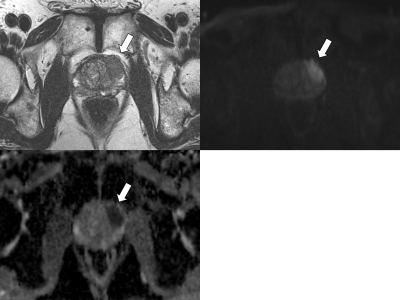 |
Computer Number: 19
2438. Prediction
of invasive cribriform carcinoma based on biparametric MRI in
the patients with clinically significant prostate cancer
T. M. Kim, H. Ahn
Seoul National University Hospital, Seoul, Korea, Republic of
Impact: Accurately predicting CRC through pre-operative
imaging could potentially improve management strategies for
csPCa patients. The imaging features identified are
straightforward to apply in clinical settings, and advanced
methods, such as radiomics, may further enhance diagnostic
accuracy.
|
|
 |
Computer Number: 20
2439. Development
and Clinical Integration of an Automated Prostate MR
Fingerprinting Pipeline
A. Sharma, E. Correia, A. Dupuis, S. Tirumani, W. Grissom,
M. Griswold, Y. Chen, L. Bittencourt
Case Western Reserve University, Cleveland, United States
Impact: MR Fingerprinting (MRF) has demonstrated
improved characterization of prostatic lesions. The
successful clinical implementation of prostate MRF enables
routine quantitative prostate tissue properties mapping.
|
|
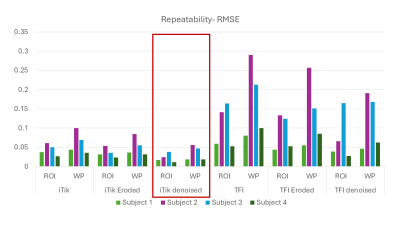 |
Computer Number: 21
2440. Investigating
Prostate Cancer Using QSM: Repeatability and Lesion Analysis
L. Muralidharan, M. Mathew, A. Retter, A. Yeung, J.
Clemente, L. Castleton, S. Kaur, J. Markus, S. Punwani, K.
Shmueli
University College London, London, United Kingdom
Impact: Using whole-prostate and two-pass masking
greatly reduced streaks from large intraprostatic
calcifications and haemorrhages. Although no significant
susceptibility increases were observed in cancerous lesions,
this repeatable, optimized high-resolution QSM pipeline will
be applied to more subjects to improve statistical power.
|
|
|
Computer Number:
2441. WITHDRAWN |
||
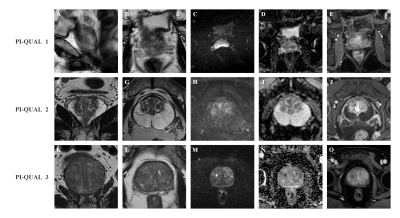 |
Computer Number: 22
2442. Multi-reader
Evaluation of the Prostate Imaging Quality Score System Version
2 (PI-QUAL V2) and its Clinical Application
Y. Cheng, L. Wang, Z. Yang, L. shen, Q. Liao, J. Qin, Y. Niu
Capital Medical University Affiliated Beijing Friendship Hospital, Beijing, China
Impact: Undoubtedly, the introduction of PI-QUAL V2
serves as the cornerstone for the widespread application of
MRI in prostate clinical practice. However, to constitute an
optimal quality assessment framework, it may still require
adaptation and fine-tuning.
|
|
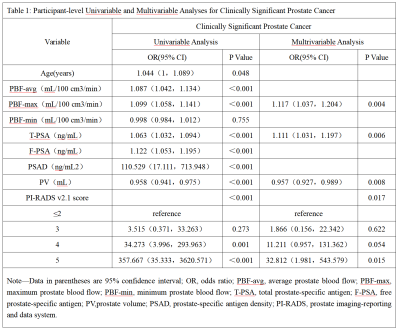 |
Computer Number: 23
2443. Prospective
Evaluation of arterial spin labeling perfusion imaging and
PI-RADS v2.1 scoring for clinically significant prostate cancer
W. Wang, Y. Xu, J. Wang, N. Liu
Anhui Provincial Hospital, Affiliated to Anhui Medical University, Hefei, China
Impact: For patients with renal insufficiency or other
reasons that prevent the use of contrast-enhanced imaging,
non-invasive methods can be employed to obtain microvascular
perfusion information. Additionally, enhancing the
diagnostic efficiency for prostate cancer, reducing
healthcare burden on patients.
|
|
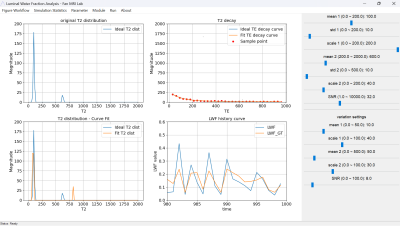 |
Computer Number: 24
2444. Prostate
Luminal Water Fraction Analysis: A Comprehensive Simulation
Platform for Algorithm Optimization and Comparison
J. Zhang, S. Cen, Z. Fan
University of Southern California, Los Angeles, United States
Impact:
Luminal Water Fraction Analysis tool provides researchers with a platform to evaluate LWF calculation algorithms, enhancing prostate cancer diagnostics. It enables more precise detection of lesions, potentially improving clinical outcomes and informing future research on algorithm development for medical imaging. |
|
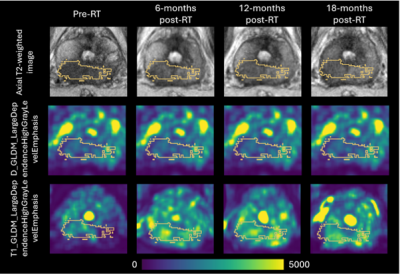 |
Computer Number: 25
2445. A
novel feature reduction framework for reliable delta-radiomics
of prostate cancer response to radiation therapy
Y-F Wang, S. Tadimalla, Y. Sun, L. Holloway, N.
Thiruthaneeswaran, S. Turner, M. Sidhom, A. Hayden, J.
Martin, A. Haworth
The University of Sydney, Sydney, New South Wales, Australia
Impact: A framework for identifying reliable features in
delta-radiomics of longitudinal prostate qMRI was developed.
Predictive models built with these robust radiomic features
may enable early detection and localisation of recurrences,
providing an opportunity for salvage therapies of
treatment-resistant tumours.
|
|
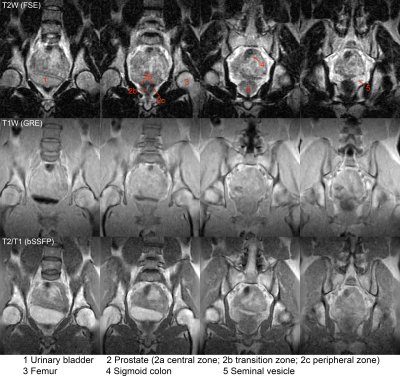 |
Computer Number: 26
2446. Pelvis
Imaging at 0.05 T
Y. Ding, S. Su, V. Lau, J. Hu, J. Zhang, X. Lin, L. Wu, X.
Li, A. Lin, A. Leong, Y. Zhao, E. Wu
The University of Hong Kong, Hong Kong, Hong Kong
Impact: Advancements in pelvis imaging using a 0.05 T
whole-body scanner have the potential to enhance
image-guided procedures, facilitate accurate targeted
biopsies, and ultimately improve patient outcomes.
|
|
 |
Computer Number: 27
2447. Deep
learning accelerated ultrafast MR imaging of the pelvis to
screen for pelvic metastases in patients with suspicion for
prostate cancer.
A. Nedelcu, C. Wilpert, B. Oerther, D. Nickel, R. Strecker,
F. Bamberg, J. Weiss, M. Russe, H. Engel
University Hospital of Freiburg, Freiburg im Breisgau, Germany
Impact: Deep learning accelerated T1w VIBE Dixon imaging
with drastically shortened acquisition time of 15 seconds
demonstrates equal or superior image quality and equal
diagnostic confidence for pelvic lymph nodes and bone
lesions in patients with suspicion for prostate cancer.
|
|
 |
Computer Number: 28
2448. A
framework for determining regions of significant anisotropy in
whole body diffusion tensor imaging. A simulation and patient
study.
S. Yu, A. Candito, B. Whitcher, S. Bottazzi, N. Tunariu, G.
Hopkinson, C. Messiou, D-M Koh, M. Blackledge
Institute of Cancer Research, London, United Kingdom
Impact: This method shows the robustness of ΔBIC to
indicate significant diffusion anisotropy at each anatomical
location.
|
|
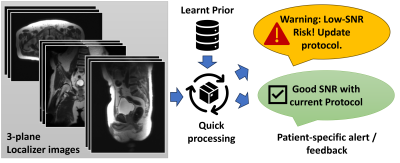 |
Computer Number: 29
2449. An
informed approach for protocol selection for clinical prostate
MRI
C. Bhushan, S. Bhushan, M. Shao, D. Shanbhag, A. Guidon
GE HealthCare Research, Niskayuna, United States
Impact: The study demonstrates that image-quality of
high-resolution image can be reliably predicted in-advance
using descriptors derived from patient's localizer images.
This will be useful for alerting technologist to make
informed choice for protocol selection.
|
|
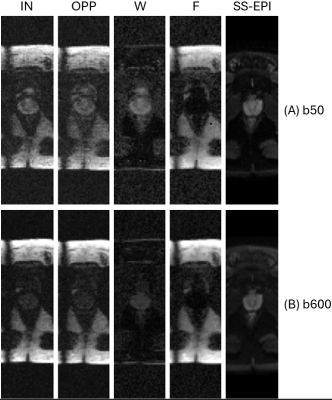 |
Computer Number: 30
2450. Dixon
water-fat separation for 3D diffusion-prepared gradient echo at
3T
Y. Ott, S. McElroy, R. Tomi-Tricot, O. Darwish, S. Kinsella,
S. Jelijeli, V. Goh, R. Neji
King's College London, London, United Kingdom
Impact: This work introduces an approach for water-fat
separation in 3D diffusion imaging, thereby enabling
excellent fat suppression.
|
|
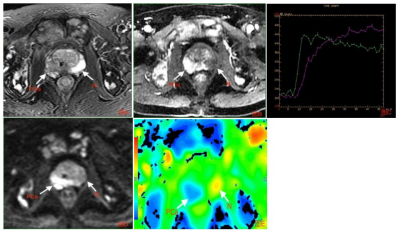 |
Computer Number: 31
2451. Using
Multimodal MRI Quantitative Metrics as Image Biomarkers to
Predict the Tumor Malignant Degree of Prostate Cancer
R. d. Zhang, Z. Chen, G. Han
Clinical medicine school of Ningxia Medical University, Bao ji, China
Impact: The ADC value, Tmax(s), SImax% and Rmax% of
multimodal MRI are correlated with the expression of P504s .
These metrics can serve as imaging biomarkers to predict
the proliferation and metabolic ability of PCa.
|
The International Society for Magnetic Resonance in Medicine is accredited by the Accreditation Council for Continuing Medical Education to provide continuing medical education for physicians.